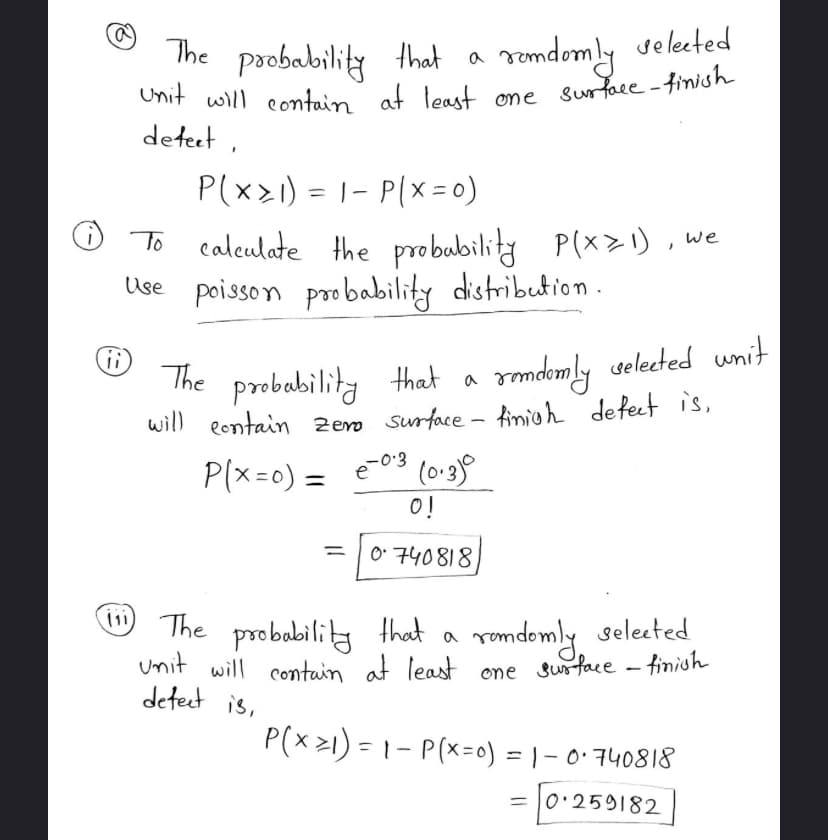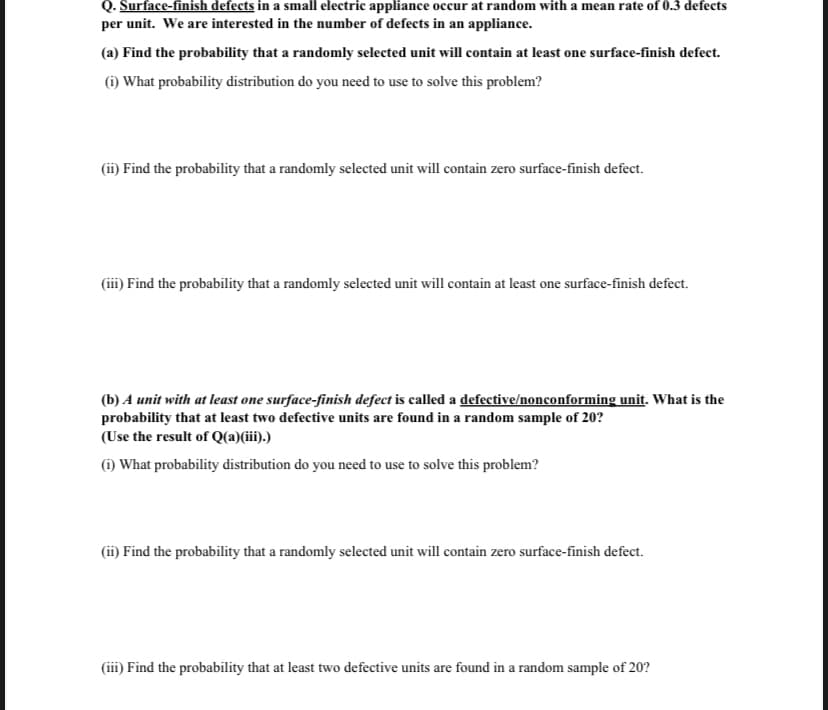(b) A unit with at least one surface-finish defect is called a defective/nonconforming unit. What is the probability that at least two defective units are found in a random sample of 20? (Use the result of Q(a)(iii).) (i) What probability distribution do you need to use to solve this problem? (ii) Find the probability that a randomly selected unit will contain zero surface-finish defect. (iii) Find the probability that at least two defective units are found in a random sample of 20?
(b) A unit with at least one surface-finish defect is called a defective/nonconforming unit. What is the probability that at least two defective units are found in a random sample of 20? (Use the result of Q(a)(iii).) (i) What probability distribution do you need to use to solve this problem? (ii) Find the probability that a randomly selected unit will contain zero surface-finish defect. (iii) Find the probability that at least two defective units are found in a random sample of 20?
College Algebra (MindTap Course List)
12th Edition
ISBN:9781305652231
Author:R. David Gustafson, Jeff Hughes
Publisher:R. David Gustafson, Jeff Hughes
Chapter8: Sequences, Series, And Probability
Section8.7: Probability
Problem 39E: Assume that the probability that an airplane engine will fail during a torture test is 12and that...
Related questions
Question
Surface-finish defects in a small electric appliance occur at random with a mean rate of 0.3 defects per unit. We are interested in the number of defects in an appliance. A unit with at least one surface-finish defect is called a defective/nonconforming unit. What is the probability that at least two defective units are found in a random sample of 20? I only need help with part B

Transcribed Image Text:ii
The probability that a
Unit will contain at least
defect,
P(x1) = 1- P(x=0)
To
calculate the probability P(x=1), we
Use poisson probability distribution.
randomly selected
one surface-finish
The probability that a
randomly selected whit
will contain zero surface - tinigh defect is,
P(x=0) = €²0:3 (0.3)0
e-0.3
0!
=
= [0740818)
(111) The probability that
selected
a
randomly
unit will contain at least one surface - finish
defect is,
P(x ≥1) = 1 - P(x=0) = 1 - 0·740818
= 0.259182

Transcribed Image Text:Q. Surface-finish defects in a small electric appliance occur at random with a mean rate of 0.3 defects
per unit. We are interested in the number of defects in an appliance.
(a) Find the probability that a randomly selected unit will contain at least one surface-finish defect.
(1) What probability distribution do you need to use to solve this problem?
(ii) Find the probability that a randomly selected unit will contain zero surface-finish defect.
(iii) Find the probability that a randomly selected unit will contain at least one surface-finish defect.
(b) A unit with at least one surface-finish defect is called a defective/nonconforming unit. What is the
probability that at least two defective units are found in a random sample of 20?
(Use the result of Q(a)(iii).)
(i) What probability distribution do you need to use to solve this problem?
(ii) Find the probability that a randomly selected unit will contain zero surface-finish defect.
(iii) Find the probability that at least two defective units are found in a random sample of 20?
Expert Solution
This question has been solved!
Explore an expertly crafted, step-by-step solution for a thorough understanding of key concepts.
This is a popular solution!
Trending now
This is a popular solution!
Step by step
Solved in 4 steps with 2 images

Recommended textbooks for you

College Algebra (MindTap Course List)
Algebra
ISBN:
9781305652231
Author:
R. David Gustafson, Jeff Hughes
Publisher:
Cengage Learning

Algebra & Trigonometry with Analytic Geometry
Algebra
ISBN:
9781133382119
Author:
Swokowski
Publisher:
Cengage

College Algebra (MindTap Course List)
Algebra
ISBN:
9781305652231
Author:
R. David Gustafson, Jeff Hughes
Publisher:
Cengage Learning

Algebra & Trigonometry with Analytic Geometry
Algebra
ISBN:
9781133382119
Author:
Swokowski
Publisher:
Cengage